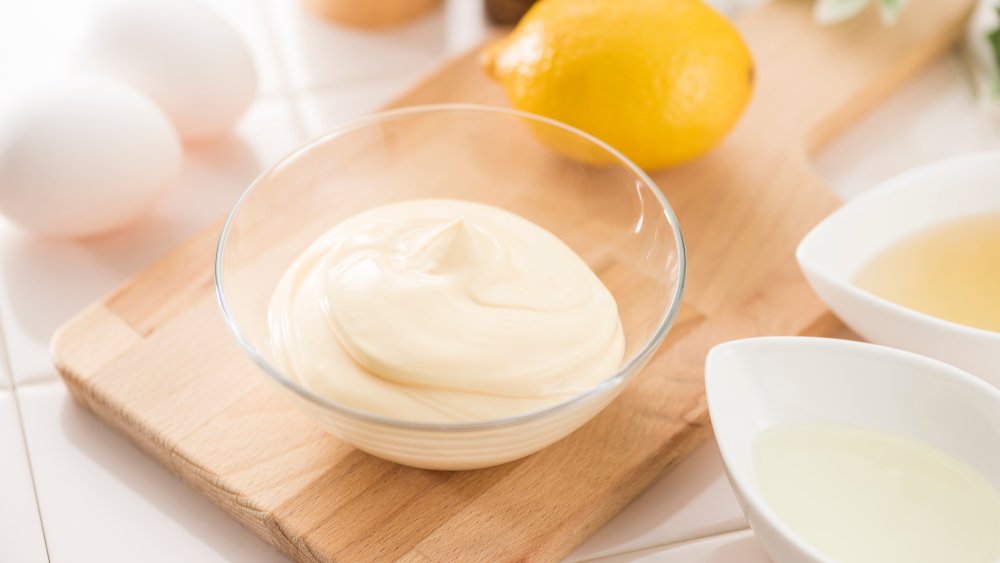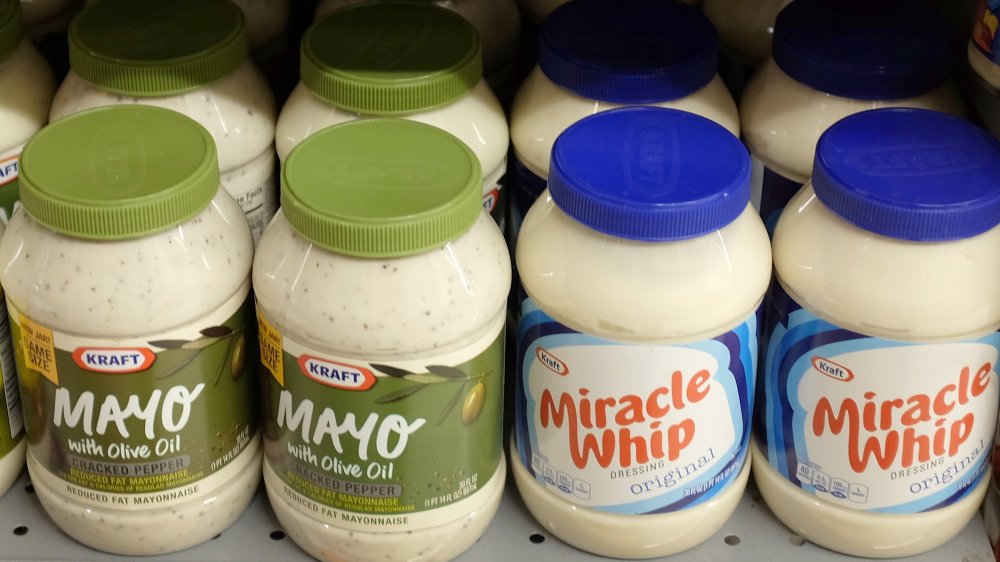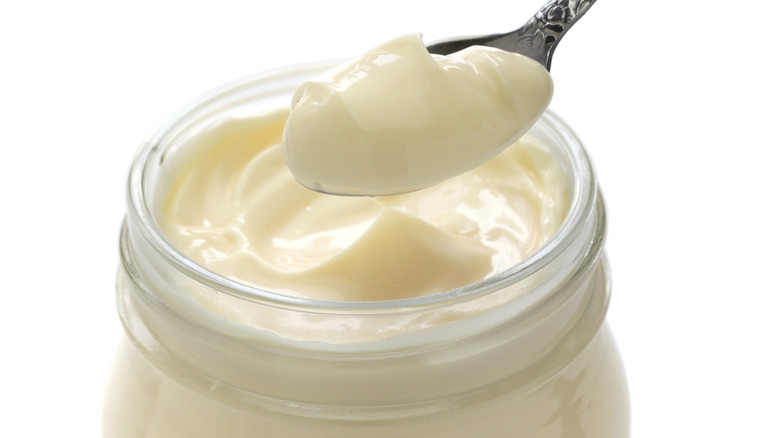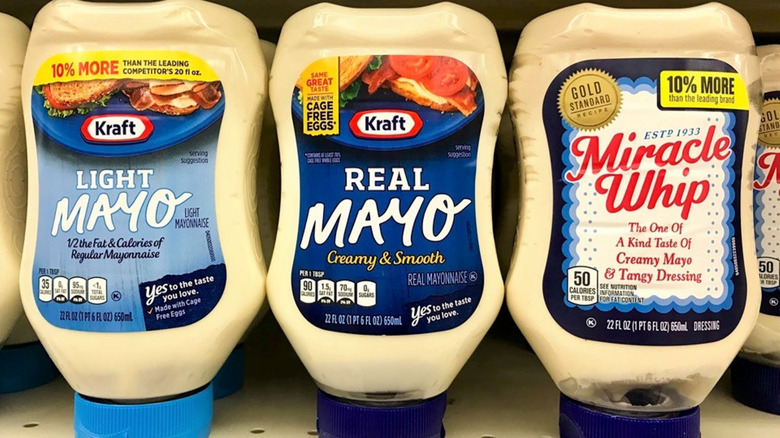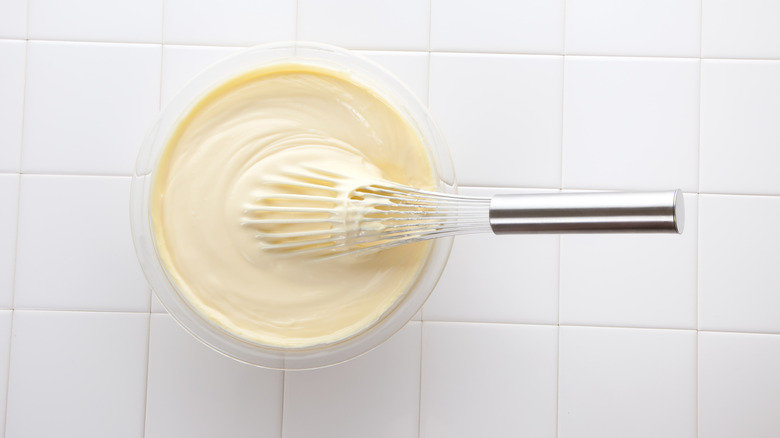The Real Difference Between Mayonnaise And Miracle Whip
Mayonnaise and Miracle Whip are easily mistaken for one other. They're both creamy, white sandwich spreads that are packaged in similar jars, and they often sit next to each other on store shelves. Are mayo and Miracle Whip the same thing, then, or is Miracle Whip a type of mayonnaise?
Technically speaking, Miracle Whip cannot be considered a type of mayonnaise at all. Per Real Simple, the U.S. Food and Drug Administration requires that mayonnaise consist of at least 65% vegetable oil by weight. But Miracle Whip contains an undisclosed — but lower — amount of this ingredient, per the Orlando Sentinel.
So, what exactly is Miracle Whip, if it's not a type of mayo? While you'd think the manufacturers might just call it a "sandwich spread," instead, they somewhat bafflingly choose to label it as a "salad dressing," per Grog to Grits. That leads one to wonder: Has anyone actually tried to use it as such? And, if so, how did they manage to spread it over each lettuce leaf?
Mayonnaise and miracle whip just taste different
What really sets Miracle Whip apart from mayonnaise is its taste. While Miracle Whip, like mayonnaise, is made with eggs, oil, and an acid ingredient such as lemon juice, it also contains a blend of spices, including mustard, paprika, and garlic. The real difference in flavor, though, lies in the fact that Miracle Whip is made with corn syrup, notes Healthline.
While Miracle Whip has a bit of tang to it, the corn syrup gives it a distinctive sweetness that some might call cloying. While not everyone is a fan of the stuff — and it probably gives foodies fits just to hear its name mentioned in polite company — Miracle Whip manufacturers are laughing all the way to the bank. Grog to Grits says it's been a huge hit since its introduction, noting that within months of its nationwide release, Miracle Whip outsold all other brands of mayo and salad dressing.
Preference for mayo or Miracle Whip could be a regional thing
As with so many food preferences, whether people go for mayo or Miracle Whip can be influenced by where they live. Simply Analytics created a "heat map" of mayo brand preferences a few years back, and the results were clear: The Northeast is all about Hellmann's, while the West Coast prefers Best Foods mayo (which is actually the same thing under a different name). Neither area is too big on Miracle Whip, but the Midwest and Deep South more than make up for it, as they can't get enough of the stuff.
A few years ago, rumors started circulating that Target had dropped the Miracle Whip brand. Did it get canceled for its high fructose corn syrup content? Was it deemed a relic of the Jell-O salad era? Well, Consumerist did some investigating, and the outlet's 2016 report on the issue found that no company policy bans sales of this product. Rather, it was just that some Targets in areas where Miracle Whip wasn't a best seller had quietly been easing it off the shelves — perhaps to make room for trendier new products like garlic aioli or sriracha mayochup. Targets in areas of the country where Miracle Whip is in demand still do carry the product, and Target reps have said that the Midwest is where it's most popular.
There are nutritional differences between mayonnaise and Miracle Whip
Despite its added sweetener, Miracle Whip has just half the calories of mayonnaise. And the fact that it's made with less oil also means it's lower in fat. That said, mayonnaise might still be a better choice for dieters. High fructose corn syrup, which is used to sweeten Miracle Whip, has been linked to creating false hunger pangs and reducing the ability to stop eating once full, per WebMD. Miracle Whip contains more additives and is more highly processed than mayonnaise; it's also made with potentially inflammation-inducing soybean oil.
While neither mayonnaise nor Miracle Whip can exactly be considered nutritious, Healthline suggests that mayonnaise is probably the better choice, particularly if you choose a healthier brand or take the time to make a homemade version. The outlet does suggest, though, that if you really want to do the right thing by your body, you'll be even better off if you ditch both sandwich spreads in favor of Greek yogurt.
You can make homemade Miracle Whip
If you're a lifelong member of Team Miracle Whip, chances are you're not planning to switch now. And even if you're not a Miracle Whip superfan, there are some recipes in which only this condiment will do, so you may find yourself in need of an ingredient you don't normally have on hand. In either instance, you might want to try a DIY version of Miracle Whip.
In this recipe from Amish 365, the corn syrup is replaced with maple syrup, with the other ingredients being water, vinegar, flour, an egg, butter, honey, salt, lemon juice, ground mustard, garlic powder, paprika, and dried basil. The water, vinegar, and flour are cooked for a few minutes to thicken them up, then all of the ingredients are emulsified in a blender.
If you already have mayo on hand, you can tweak it to make a Miracle Whip substitute. According to this recipe from Food.com, you make an additive by boiling vinegar, cornstarch, sugar, paprika, garlic powder, and ground mustard, then mix it with your mayo to add that distinctive Miracle Whip-like flavor. As you will note, neither of these recipes calls for high fructose corn syrup, which isn't something the typical home cook has on hand. They also lack chemical additives. And, of course, you can reduce the sweetening and salt levels to taste, meaning DIY Miracle Whip has the potential to be a healthier alternative to the store-bought stuff.
